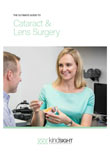Do you know the Signs of Cataract?
Would you know if you had a cataract? Cataracts are a very common eye disease; in fact, they are the leading cause of reversible blindness in the world. There are many signs of cataract development and its important to know what they are.
A cataract is a clouding of the natural crystalline lens, and in its early stages can often go by undetected as they cause no vision problems or other symptoms. However, as they develop, cataracts can cause significant changes to your vision and in severe cases cause blindness (not common in Australia where we have access to high quality health care).
While you may generally know about or have heard of cataracts, what you may not have known is that there is no eye drop or medication that can stop the onset or treat cataracts once formed. Although, by not smoking, minimising alcohol intake, eating a healthy diet (getting all of your antioxidants!) and protecting yourself against UV radiation, it is possible to slow their progression.
Most cataracts are linked to ageing, but don’t be fooled – they can occur in younger people too. For example, genetic conditions, medications, and injury have been known to cause cataracts in people of all ages.
What are the Signs of Cataract?
So what do you need to look out for? You may notice one or more of the following signs if you have a cataract:
- Light sensitivity – the glare coming from bright lights is dazzling and uncomfortable
- Blurred vision – where the world seems dim, cloudy or blurry. This symptom tends to worsen slowly over time
- Haloes – appearing around light sources, making activities like driving difficult (and dangerous!), particularly at night when streetlights and headlights are on
- Trouble seeing easily in low light levels – for example, driving at night or in the rain is increasingly difficult or finding that you need more light to read
- Colour distortion – bright colours appear faded or have a yellow tint. How you see colour will change, and your ability to tell the difference between colours will be reduced
- Your glasses don’t last – have you found yourself needing to update your glasses or contacts more frequently than in the past? If your eyesight is changing rapidly, see your eye care professional immediately. If it’s not cataracts, it may be another eye condition
- You have multiple risk factors – for example:
- You are over 60
- History of heavy alcohol intake or smoking
- Obesity, diabetes, or high blood pressure
- Previous eye injury
- Family history of cataracts
- High exposure to UV or previous exposure to radiation
Find out more about cataracts here. If you have any of the signs or symptoms mentioned above, make sure you see an eye care professional to discuss your vision changes and arrange an eye exam.


